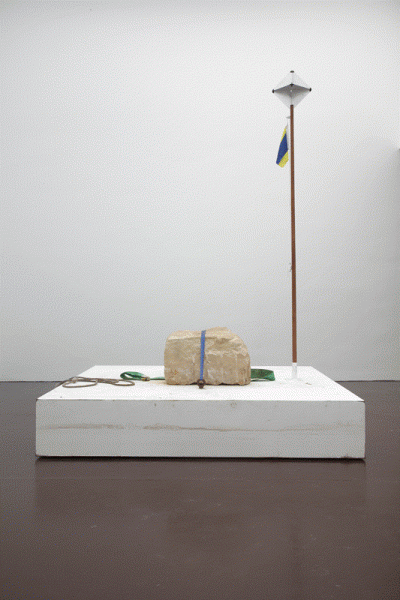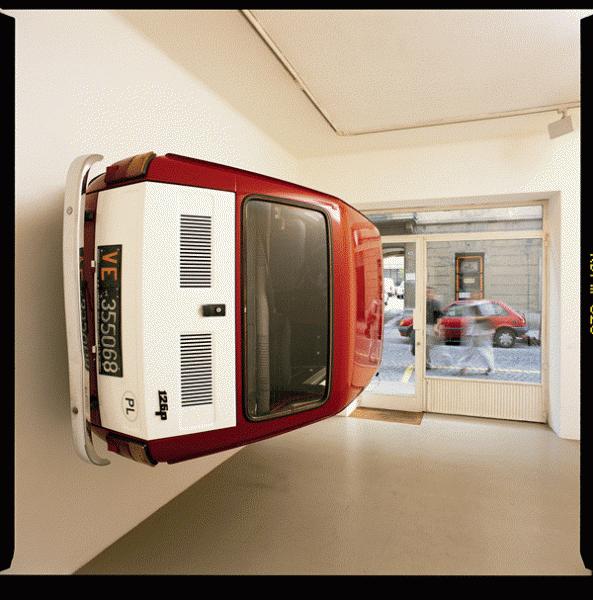
April 2013
Simon Starling’s use of travel acts both as a mirror of the irrational development models of our societies and as an invitation to invent other practices.
Starling develops a body of work that must be approached through the various modes of expression he uses; the installations, narratives, sculptures, publications and his own travels constitute a unit [1]. Movement is a recurring theme in his work. Born in 1967, the English artist belongs to the tradition of conceptual (and post-conceptual) artists whose approach demands simultaneous consideration of the intentions, written work and realizations themselves. The journey is never seen as an end but rather as a process or part of the work process—a channel of mutation that affects the internal structure of the objects moved. In Flaga ( 1972-2000 ) (2000), the Fiat 126’s route from Italy to Poland is the story of the hybridization of a car that ends up hanging on a gallery wall, painted in the colors of the Polish flag, questioning the meaning of borders and their relationship to the economy and political regimes, as well as the porosity of identities across space. In Starling’s work, movement is almost always that of materials, objects, or plants – more so than that of people, who in general are absent from the intentions of the artistic device –, as if the mobility of tomorrow targeted much more than just people.

In Rockraft (2008), a one-ton stone was transported from the neighborhood of Avonmouth -- a distance of nine hundred kilometers - aboard a floating platform to the port of Bristol, using only the force of the tide (in this case, the second largest tidal range in the world). Upon arrival in Bristol, the stone made another journey, this time virtual. Its form was scanned and replicated using an advanced milling machine. The original stone and its reproduction were exhibited together. It is as if the physical journey of the one-ton rock was somehow annulled by ultra-modern technical methods that allow us to recreate the same stone by simple virtual displacement. The monumental nature of the object moved virtually further enhances what can be read as a prophecy of the future of freight mobility, in the tradition of John Urry and Thomas Birtchnell’s “Technologies and Travel.” Simon Starling’s work illustrates the “additive manufacturing” processes theorized by their research team at Lancaster University.
In rescued Rhododendrons (2000), the artist transports a rhododendron from Scotland to Spain. The plant was originally imported from Spain to Scotland in the 18 th century, where it became invasive to the point of threatening the native flora and was subsequently subject to a policy of systematic uprooting, showing how a simple set of borders can change a good’s status.

More important still, his work reflects the complex network of exchanges and interconnections on which our globalized societies depend. Starling shows us that anything in the world can be affected by mobility and that nothing is anchored in an immutable way — not even a ton of stone. But if everything can move, everything is also interdependent, so that this increase in mobility comes with a cascade of imbalances (in this case, the natural imbalance caused by the introduction of the rhododendron). Everything that moves changes – both itself and its surroundings. For Adrian Paci, while mobility affects individuals’ stability personally and in terms of identity, for Starling it is the stability of natural, historical, and conceptual systems that is in question. Aboard the boat-work Autoxylopyrocyclobotos (2006), Starling and his partner move across Loch Long in Scotland, powering the steam engine that propels the boat with wood from its very hull, until it finally sinks. Is not the serpent biting its own tail (the uroboros , to which the work refers) that of mobility or, more broadly, that of development which, under current conditions, is leading nowhere other than to its own downfall?
[1] In 2009, the MAC/VAL dedicated an exhibition to the artist entitled THEREHERETHENTHERE: works 1997–2009
Autres publications